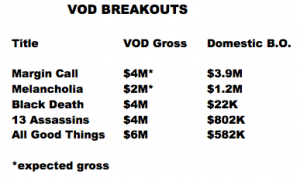“It is being comfortable with change and flow as the day to day conditions of knowledge production and dissemination, and recognising that all of this may change, and appear differently in six months. What underlies such change, however, are the principles of distributed content production and sharing, folksonomies, trust networks and having access to skills that let you collate and build with these varieties of content and knowledge.”
Miles, Adrian. “Network Literacy: The New Path to Knowledge.” Screen Education Autumn.45 (2007): 24–30.
Since the establishment of home video as a part of the film industry, the standard distribution of a film has been this: first released in cinemas, after approximately 16 weeks, it is released on video/DVD, and several months after that, it is released to free-to-air television. However, in recent years, this system has seen a significant amount of changes, largely due to the induction of digital viewing of films, or video on demand(VOD) services. The perceived potential of these services has led distribution companies to be more experimental in how they release films, essentially beginning what could change film distribution massively. This experimentation has seen a range of different forms of distribution, including shorter windows between theatrical releases and VOD releases, day and date releases, where both are released simultaneously, and even instances in which films are released on VOD before in theatres. With all of these new methods being introduced, questions arise over whether cinemas, and the tradition that comes with them, will be able to coexist with the rising power of VOD. These questions have proven extremely divisive among those in the film industry, as ideas of tradition, the ‘ultimate film experience’, convenience and accessibility drive the different views.
One thing that is important to acknowledge is that, as it stands today, the larger ‘blockbuster’ films continue to wholeheartedly follow the standard release. Financially, this remains the most beneficial method for them to take. These recent, more experimental release methods, are much more relevant to independent cinema.
This innovation in distribution has been fully necessary, as VOD has been viewed as a ‘life preserver’ for the independent film industry by Brent Lang of The Wrap, among others. Putting it simply, the co-owner of Magnolia Pictures and a front runner in the development of VOD releases, Mark Cuban claims that ‘for most independent movies, VOD will be far and away the largest source of revenue in the future’. While this is very likely true, it does not necessarily mean that independent films will not find a place in theatres, as they have for many years.
The first instance of major innovation in the film distribution front came in 2006, when highly regarded director, Steven Soderbergh, released his latest film, Bubble, simultaneously in theatres and on DVD and VOD services. This saw varied responses from people of the industry as well as the public. Perhaps most vocal were the theatre owners, as the idea of a simultaneous release stood as a threat to the theatre audience numbers, their thought process being: why would people go to theatres if they could just view the film at home?. National Association of Theatre Owners general counsel Kendrick Macdowell said that simultaneous release would be ‘fatal to our industry’. This opposition resulted in several cinemas boycotting the film, which became a common action for them to take. At the time this seemed a clear shortcoming to the simultaneous release, as it appeared theatre owners were far from willing to cooperate. However, as films have continued to follow this release style, it is in many cases no longer financially beneficial or even viable for theatres to boycott releases. The other major opposition to Bubble’s distribution method was what you might call the cinema traditionalists, who saw the method as a threat to ‘cinema-going experience’. What exactly this experience this is isn’t clear. Of this opposition, filmmakers seem to be quite vocal. At the time of Bubble’s release, director M. Night Shyamalan took a heavy stance against it, claiming to feel that he thinks Soderbergh is ‘going to kill it’ – ‘it’ being cinema. Furthering his point, and also bringing up that idea of the ‘cinema-going experience’, he said that movies will lose their ‘magic’ if not played in theatres, ultimately labelling the distribution method as ‘heartless and soulless and disrespectful’. Going from one traditionalist’s love of cinema, another high profile filmmaker, David Lynch, has made his hatred for forms of VOD viewing known:
Amongst all of this vocal opposition, there is also a large amount of supporters of early VOD releases, in fact much larger than those who oppose. In response to the release of Bubble specifically, the film’s distributor, Todd Wagner, made clear that ’this is not an attack on the theatrical exhibition industry’, which director Soderbergh agreed with, declaring ‘people will always go to the movies’. What this suggests is that, rather than a threat to theatres, the simultaneous release method benefits their wider audiences. When considering the audience of these films, the strengths of early VOD releases are suddenly extremely apparent. Many of the potential audiences are in positions where going to a cinema to view a film is simply not a reasonable expectation. This may be due to location reasons, as many smaller towns do not have cinemas, or certainly not cinemas screening some of the smaller independent films – like Bubble. Another common scenario is parents essentially not being able to leave their children for the night. These simple and relatable reasons would generally result in them being removed from a film’s potential audience, until several months later, when the film makes its standard release on DVD and VOD. With the introduction of simultaneous release, this completely evens out the audience playing field, as someone living in a rural town can access a film just as easily and quickly, as someone in a major city – showing how the two platforms can coexist. Putting the audience first, this would strongly indicate that these changes in distribution are worthwhile.
What the opposition to these developments in distribution suggests is that ultimately, they believe theatres cannot match VOD directly, and it is in the best interest of cinema to simply avoid the conflict for as long as possible. This viewpoint demonstrates two major shortcomings: one being the failure to see the two platforms as being able to complement each other and coexist, and the other being the people of cinema’s unwillingness to make any changes or improvements to the ‘cinema-going experience’ in order to make it, in simple terms, better. One example in which successful attempts were made to change this experience was the release of Kevin Smith’s 2011 film, Red State. The distribution method of this film was perhaps the most innovative since Bubble, as it involved a VOD release more than a month before its theatrical release. This method is known as UltraVOD and still remains rare, though it is much more common since the success of Red State.
An obvious question that arose from Smith’s ordering of release was ‘why would people see the film in theatres after it’s been available on VOD for over a month?’. Smith’s answer to this question is what makes the release style so innovative, as he provides an incentive to see the film in theatres. Smith himself explains the incentive: ‘like let’s say Red State is showing at your local multiplex. But then right after the movie ends, a live, interactive Q&A with the filmmaker starts, beamed into the theatre via satellite’. This valuing of and involvement with the audience clearly strengthens the act of seeing a movie in a cinema. Mike Masnick strongly supported the incentive in his article in techdirt, stating it was ‘adding additional value to the theatrical performance so that people have more reasons to go out to that, even if they can access the VOD version at home’. Masnick also stresses the fact that earlier VOD releases should lead to the development of cinemas, contending ‘it would put in place more incentives for…theatre owners to make going to the theatre a much more enjoyable experience because they wouldn’t just be competing with other theatres, but the home theatre as well. They’d have to play to their strengths and focus on how to make “going out to the theatre” a totally different experience from staying in to watch a movie. The potential is enormous, but we won’t see much of it if theatre owners can remain lazy and uncreative by keeping studios from giving customers the choice they deserve.’
Since these significant innovations in independent film distribution, theatrical and VOD releases have managed to coexist, as VOD releases have become increasingly early. In many cases, VOD has resulted in films performing much better than they would have if only released theatrically(see above image). Most recently, Bong Joon-ho’s Snowpiercer(2013) had a VOD release just two weeks after its theatrical. This was considered quite controversial, but after five weeks of theatrical release, and two weeks of being out on VOD, it had made $3.9 million and $3.8 million on the respective platforms. The fact that it was able to make solid amounts on both platforms demonstrates their ability to complement each other.On the issue of the relationship between theatres and VOD, highly acclaimed filmmaker, Chris Nolan, had several things to say in his article for The Wall Street Journal, where he optimistically explored that current state and the future of cinema. Here he identifies that both theatre and VOD revenue are expected to grow in the coming years(see image below). Although electronic home video is expected to grow far more rapidly than theatres, it is clear that they will be able to coexist and thrive, at least until 2018.


